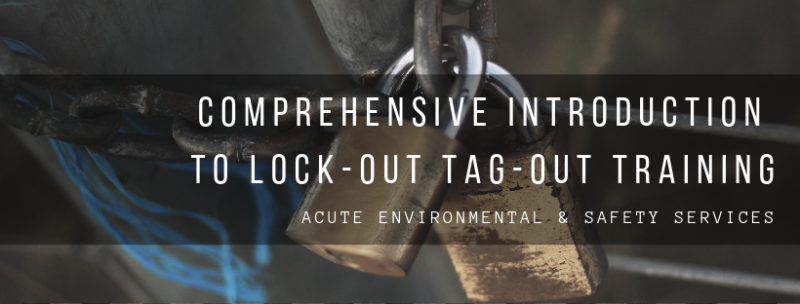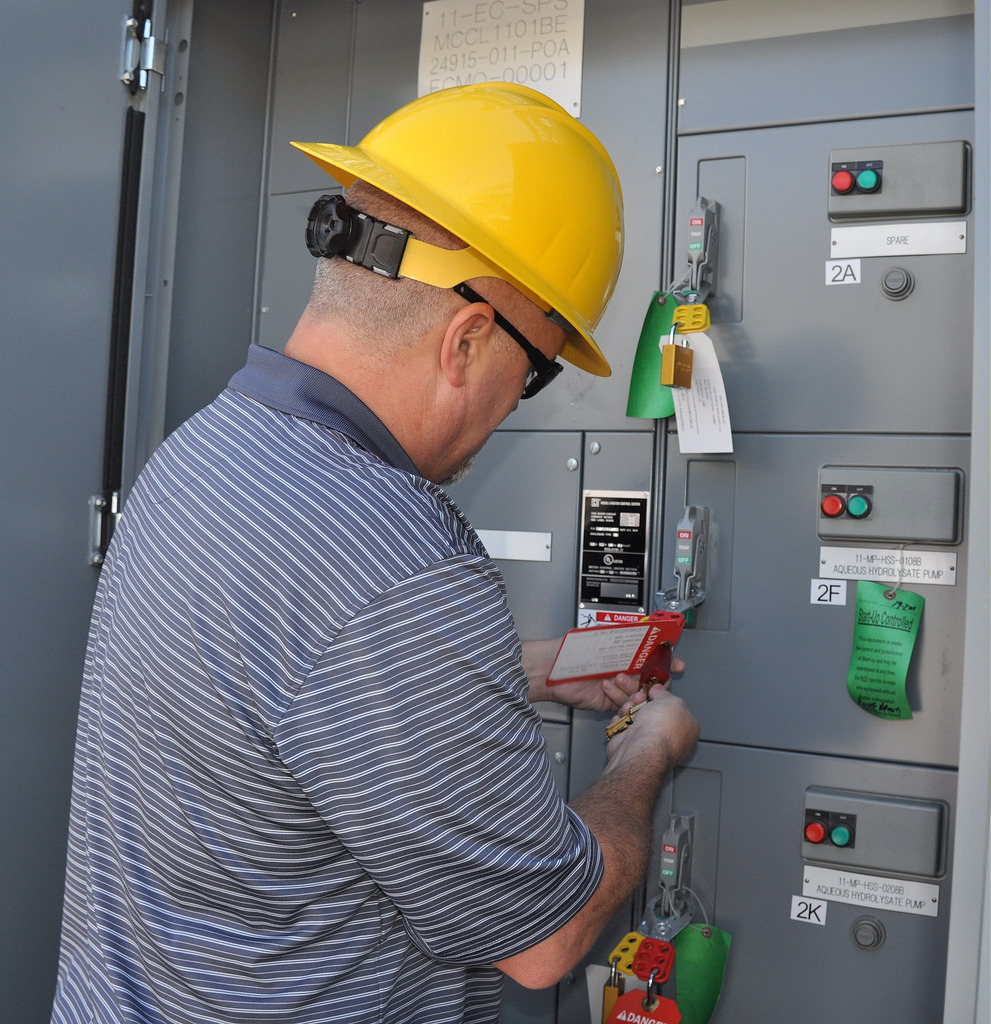
If you work around electrical, thermal, chemical, pneumatic, hydraulic, mechanical, or gravitational energy, then lock-out/tag-out training is a necessity. ACUTE Environmental & Safety Services offers a training program that will teach you the methods and legislative requirements for hazardous energy control in the workplace. Contact ACUTE today to register.
Comprehensive Introduction to Lock-Out/Tag-Out Training
What is lock-out/tag-out?
Lock-out is defined in the Canadian standard CSA Z460-13 “Control of Hazardous Energy – Lockout and Other Methods” as the “placement of a lockout device on an energy-isolating device in accordance with an established procedure,” according to the Canadian Centre For Occupational Health and Safety. A lockout device is “a mechanical means of locking that uses an individually keyed lock to secure an energy-isolating device in a position that prevents energization of a machine, equipment, or a process.”
In other words, lock-out is the isolation of energy by placing the system in a safe mode. The energy-isolating device can be a manually operated disconnect switch, a circuit breaker, a line valve, or a block, and in most cases, these devices will have loops or tabs which can be locked to a stationary item in a safe (de-energized) position. The locking device (or lockout device) can be any device that has the ability to secure the energy-isolating device in a safe position.
Tag-out is a corresponding labelling process that is always used when lock-out is required. The process of tagging out a system involves attaching a standardized label that includes the following information:
- Why the lock-out/tag-out is required (repair, maintenance, etc.).
- Time of application of the lock/tag.
- The name of the authorized person who attached the tag and lock to the system.
Basically, a lock-out/tag-out program helps prevent contact with a hazard while performing tasks that require the removal, bypassing, or deactivation of safeguarding devices, the unintended release of hazardous energy, and the unintended start-up or motion of machinery, equipment, or processes.

Lock-out is the isolation of energy by placing the system in a safe mode.
Who needs lock-out/tag-out training?
Employers, supervisors and workers who may be involved with planning or performing work that may expose a worker to hazardous energy – electrical, thermal, chemical, pneumatic, hydraulic, mechanical, or gravitational – will find this course to be extremely useful.
As CCOHS points out, “Safety devices such as barrier guards or guarding devices are installed on systems to maintain worker safety while these systems are being operated.”
With tasks such as maintenance, repair, or set-up, or the removal of jams, clogs, or misaligned feeds are performed, the main method used and recommended to protect workers is the use of a lock-out/tag-out program.

Maintenance workers, industrial/agricultural equipment operators, millwrights, electricians, and HVAC technicians are just a few of the occupations that will find the practical application of this course helpful.
What You Will Learn
The lock-out/tag-out training teaches students the methods and the legislative requirements for hazardous energy control in the workplace. Again, all hazardous forms of energy must be locked out or blocked to ensure that machinery or equipment does not turn on or move during installation, repair, or maintenance, and you will, therefore, learn the basics, including the following:
- Lock-out/Tag-out definitions
- Legislative requirements
- General responsibilities
- Factors to consider when locking out equipment
- Lockout procedures
- Preparation for Lock-out/Tag-out
- Machine or equipment shutdown and isolation
- Application of Lock-out/Tag-out
- Verification of isolation
- Lock-out/Tag-out interruption
- Release from Lock-out/Tag-out
- CSA Standard Z460 Control of hazardous energy – Lockout and other methods
Participants will learn through classroom interaction with experienced instructors, the exploration of legislative requirements, demonstration and hands-on training in the care and use of equipment, and detailed handouts, videos, and quizzes.
Once the training has been taken, it should be reviewed at least once a year in your workplace.

You should expect Lock-out/Tag-out training to run half a day (4 hours in length).
Trust ACUTE For Lock-Out/Tag-Out Training
 ACUTE provides comprehensive health and safety training, on-site safety services, and consulting services. With over 100 years of combined experience, company staff offer more than theoretical or abstract ideas. ACUTE offers solutions.
ACUTE provides comprehensive health and safety training, on-site safety services, and consulting services. With over 100 years of combined experience, company staff offer more than theoretical or abstract ideas. ACUTE offers solutions.
With a vast array of clients in manufacturing, construction, agriculture, health, academic, and government sectors, ACUTE brings best safety practices from across the spectrum to your workplace.
ACUTE provides a wide range of training courses in addition to lock-out/tag-out, including spill response training, working at heights, 40 Hour Hazwoper, and confined space entry – to name just a few. To view the full list of courses, click here.
All of ACUTE’s training services emphasize client participation. Our staff build a relationship with clients and serve as a touchstone for advice anytime moving forward.
“ACUTE Environmental & Safety Services has been provided OABA members in the agri business sector with excellent training services since January, 2018. OABA recommends ACUTE as a quality health and safety training provider.” – Dave Buttenham
Read more customer reviews here.



